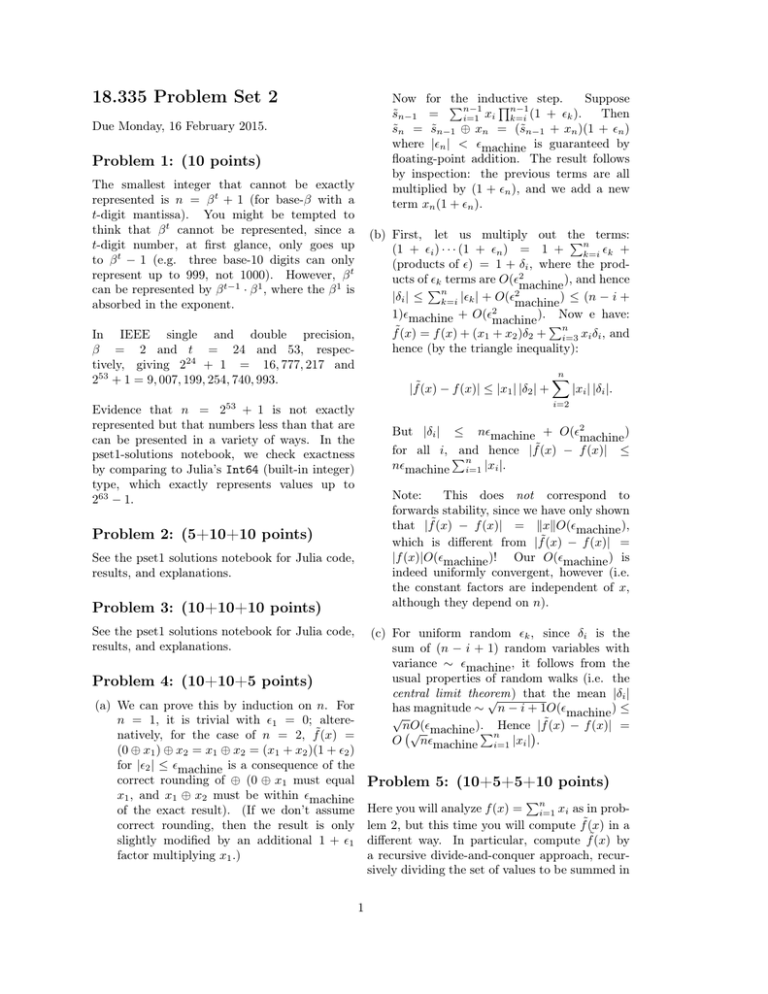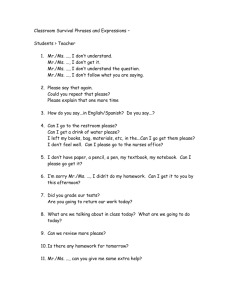18.335 Problem Set 2 Problem 1: (10 points)
advertisement

18.335 Problem Set 2 Now for P the inductive Suppose Qn−1 step. n−1 s̃n−1 = x (1 + ). Then i k i=1 k=i s̃n = s̃n−1 ⊕ xn = (s̃n−1 + xn )(1 + n ) where |n | < machine is guaranteed by floating-point addition. The result follows by inspection: the previous terms are all multiplied by (1 + n ), and we add a new term xn (1 + n ). Due Monday, 16 February 2015. Problem 1: (10 points) The smallest integer that cannot be exactly represented is n = β t + 1 (for base-β with a t-digit mantissa). You might be tempted to think that β t cannot be represented, since a t-digit number, at first glance, only goes up to β t − 1 (e.g. three base-10 digits can only represent up to 999, not 1000). However, β t can be represented by β t−1 · β 1 , where the β 1 is absorbed in the exponent. (b) First, let us multiply out the Pn terms: (1 + i ) · · · (1 + n ) = 1 + k=i k + (products of ) = 1 + δi , where the products of k terms are O(2machine ), and hence Pn |δi | ≤ k=i |k | + O(2machine ) ≤ (n − i + 1)machine + O(2machine ). Now e have: Pn f˜(x) = f (x) + (x1 + x2 )δ2 + i=3 xi δi , and hence (by the triangle inequality): In IEEE single and double precision, β = 2 and t = 24 and 53, respectively, giving 224 + 1 = 16, 777, 217 and 253 + 1 = 9, 007, 199, 254, 740, 993. |f˜(x) − f (x)| ≤ |x1 | |δ2 | + n X |xi | |δi |. i=2 53 Evidence that n = 2 + 1 is not exactly represented but that numbers less than that are can be presented in a variety of ways. In the pset1-solutions notebook, we check exactness by comparing to Julia’s Int64 (built-in integer) type, which exactly represents values up to 263 − 1. nmachine + O(2machine ) for all i, P and hence |f˜(x) − f (x)| ≤ n nmachine i=1 |xi |. But |δi | ≤ Note: This does not correspond to forwards stability, since we have only shown that |f˜(x) − f (x)| = kxkO(machine ), which is different from |f˜(x) − f (x)| = |f (x)|O(machine )! Our O(machine ) is indeed uniformly convergent, however (i.e. the constant factors are independent of x, although they depend on n). Problem 2: (5+10+10 points) See the pset1 solutions notebook for Julia code, results, and explanations. Problem 3: (10+10+10 points) See the pset1 solutions notebook for Julia code, results, and explanations. (c) For uniform random k , since δi is the sum of (n − i + 1) random variables with variance ∼ machine , it follows from the usual properties of random walks (i.e. the central limit theorem) that the mean |δi | √ has magnitude ∼ n − i + 1O(machine ) ≤ √ ˜ nO( √ machine ).PnHence |f (x) − f (x)| = O nmachine i=1 |xi | . Problem 4: (10+10+5 points) (a) We can prove this by induction on n. For n = 1, it is trivial with 1 = 0; alterenatively, for the case of n = 2, f˜(x) = (0 ⊕ x1 ) ⊕ x2 = x1 ⊕ x2 = (x1 + x2 )(1 + 2 ) for |2 | ≤ machine is a consequence of the correct rounding of ⊕ (0 ⊕ x1 must equal x1 , and x1 ⊕ x2 must be within machine of the exact result). (If we don’t assume correct rounding, then the result is only slightly modified by an additional 1 + 1 factor multiplying x1 .) Problem 5: (10+5+5+10 points) Pn Here you will analyze f (x) = i=1 xi as in problem 2, but this time you will compute f˜(x) in a different way. In particular, compute f˜(x) by a recursive divide-and-conquer approach, recursively dividing the set of values to be summed in 1 this produces ∼ 2n/N function calls—this is negligible compared to the n − 1 additions required as long as N is sufficiently large (say, N = 200), and the efficiency should be roughly that of a simple loop. (See the pset1 Julia notebook for benchmarks and explanations.) two halves and then summing the halves: if n = 0 0 f˜(x) = x1 if n = 1 , ˜ f (x1:bn/2c ) ⊕ f˜(xbn/2c+1:n ) if n > 1 where byc denotes the greatest integer ≤ y (i.e. y rounded down). In exact arithmetic, this computes f (x) exactly, but in floating-point arithmetic this will have very different error characteristics than the simple loop-based summation in problem 2. Using a simple loop has error bounds that grow as N as you showed above, but N is just a constant, so this doesn’t change the overall logarithmic nature of the error growth with n. A more careful analysis analogous to above reveals that the worst-case error Pgrows as [N + log2 (n/N )]machine i |xi |. Asymptotically, P this is not only log2 (n)machine i |xi | error growth, but with the same asymptotic constant factor! (a) Suppose n = 2m with m ≥ 1. We will first show that f˜(x) = n X i=1 xi m Y (1 + i,k ) k=1 where |i,k | ≤ machine . We prove the above relationship by induction. For n = 2 it follows from the definition of floating- (d) Instead of “if (n < 2),” just do (for example) “if (n < 200)”. See the notebook for code point arithmetic. Now, suppose it is true for and results. n and we wish to prove it for 2n. The sum of 2n number is first summing the two halves recursively (which has the above bound for each half since they are of length n) and then adding the two sums, for a total result of # " n 2n m m X Y X Y 2n xi (1 + i,k ) (1+) f˜(x ∈ R ) = xi (1 + i,k ) + i=1 k=1 i=n+1 k=1 for || < machine . The result follows by inspection, with i,m+1 = . Then, we Q use the result from probm lem 2 that k=1 (1 + i,k ) = 1 + δi with |δi | ≤ mmachine + O(2machine ). Since m = log2 (n), the desired result follows immediately. (b) As in problem 2, our δi factor is now a √ sum of random i,k values and grows as m. That is, p we expect that the average error P grows as log2 nO(machine ) i |xi |. (c) Just enlarge the base case. Instead of recursively dividing the problem in two until n < 2, divide the problem in two until n < N for some N , at which point we sum the < N numbers with a simple loop as in problem 2. A little arithmetic reveals that 2






